The paper describes major aspects of the “New Economy” to understand the situation in this global and interlinked sector, which favors intangible things. The focus of the paper lies on an analysis of the “Freeconomy” phenomenon implementing microeconomic concepts as well as models from behavioral economics to observe demand side tendencies towards free information goods. The final purpose lies in illustrating appropriate competitive business strategies to face the “gratis culture”.
Inhaltsverzeichnis (Table of Contents)
- Abstract
- Table of Contents
- Table of Figures
- Table of Abbreviations
- Table of Mathematical Variables
- Introduction
- Development of a “New Market” in Germany
- Classification of information goods
- Freeconomics
- Definition
- Why can online businesses offer goods for free?
- The paradoxon of information goods
- Free from the demand-side perspective
- Microeconomic aspects of free
- Utility function and determinants of demand
- The free rider concept and piracy
- Free in Behavioral economics
- Anchoring
- Focusing effect
- Microeconomic aspects of free
- Who pays wages in a Freeconomy
- Cross Product Subsidy Models
- Cross Customer Subsidy Models
- Cross Time Subsidy Models
- Conclusion
- References
Zielsetzung und Themenschwerpunkte (Objectives and Key Themes)
This working paper aims to examine the phenomenon of "Freeconomics" within the digital economy, analyzing how consumers react to free access to information goods and the implications for businesses. It explores the economic factors behind free goods, including the nature of information goods, the paradox of information goods, and the influence of behavioral economics on consumer behavior.
- The "New Economy" and its impact on information goods
- The phenomenon of "Freeconomics" and the rise of free information goods
- The paradox of information goods and its implications for businesses
- The impact of behavioral economics on demand for free information goods
- Strategies for businesses operating in the "Freeconomy"
Zusammenfassung der Kapitel (Chapter Summaries)
- Introduction: This chapter provides an overview of the digital economy, including the rise of "Freeconomics" and the "gratis culture" where consumers increasingly favor free access to information goods. It discusses the development of the "New Market" in Germany and the emergence of digital businesses in the IT sector.
- Freeconomics: This chapter defines "Freeconomics" and explores why online businesses can offer goods for free. It also examines the paradox of information goods, where their value often increases with wider distribution.
- Free from the demand-side perspective: This chapter analyzes consumer behavior in the context of free information goods. It examines the influence of microeconomic factors, such as utility function and free riding, as well as the role of behavioral economics, specifically focusing on anchoring and the focusing effect.
- Who pays wages in a Freeconomy: This chapter explores different business models that allow for the provision of free information goods. It discusses the concepts of Cross Product, Cross Customer, and Cross Time Subsidy models.
Schlüsselwörter (Keywords)
The primary focus of this paper lies within the realms of "Freeconomics", information goods, network effects, free-rider problems, behavioral economics, and strategic business models for the digital economy. It further incorporates key terms such as demand for network goods, free information goods, and net business strategies.
- Quote paper
- Felix Baumann (Author), 2011, Freeconomics: Do consumers tend to discriminate pay-models for information goods?, Munich, GRIN Verlag, https://www.grin.com/document/207898



